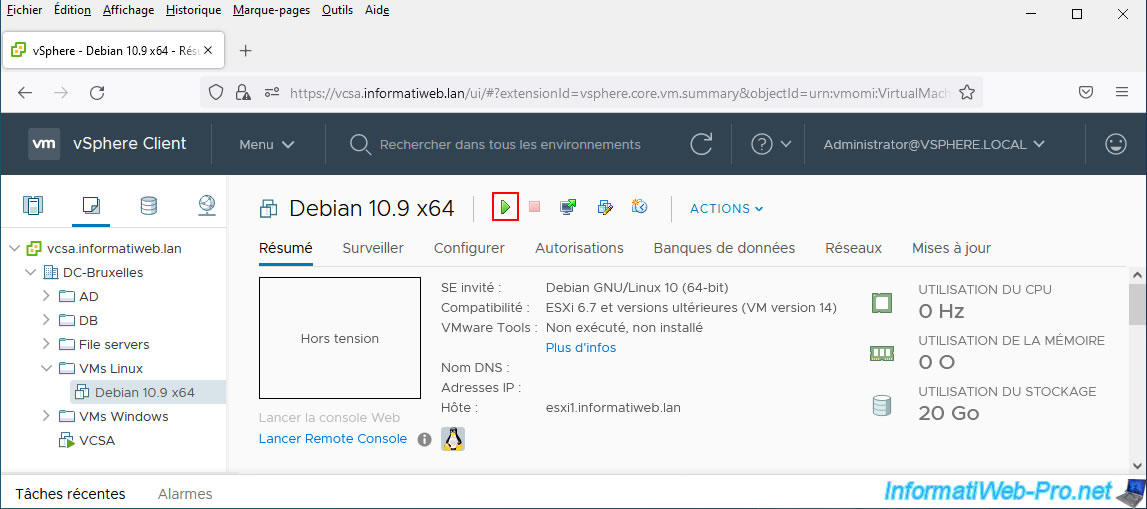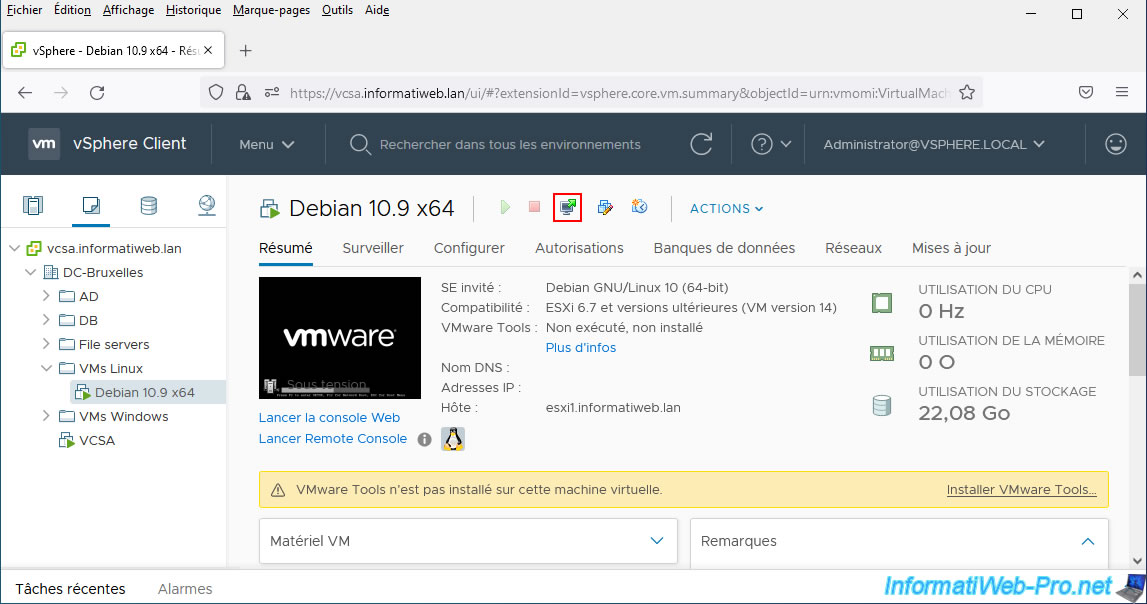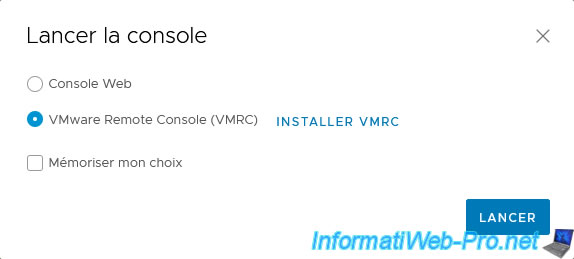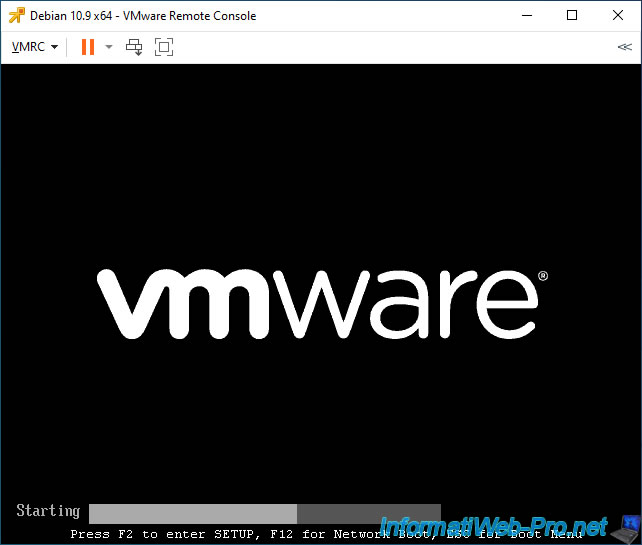Create a virtual machine with Linux as a guest OS on VMware vSphere 6.7
- VMware
- VMware vCenter Server (VCSA), VMware vSphere
- 29 March 2024 at 13:39 UTC
-

- 2/2
4. Start your Linux virtual machine
Click on its name to view this virtual machine and click on the green triangle icon.

Once the virtual machine has started, access its console by clicking on the 3rd icon.
Note: you can also click on one of the links provided just below the preview of your VM screen.

Choose whether you prefer the web console or the VMRC console, then click: Launch.
Personally, we recommend using the "VMware Remote Console (VMRC)" version, as it is much more convenient and avoids changing the screen resolution in the guest OS.

The VMware logo appears briefly when starting your virtual machine.
Note that its appearance is not exactly the same depending on whether you are using a BIOS (PhoenixBIOS based) or UEFI firmware.

The installer for your Linux distribution appears.
In our case, that of Debian 10.

Since all Linux distributions are different (although they are based on each other), we will not detail the installation of Debian in this tutorial.
However, during the installation of your Linux distribution, remember to select the right country and the right keyboard layout so as not to be hassled later to type commands in the terminal of your Linux distribution.

Wait while your Linux distribution installs.

5. Install VMware Tools on Linux
To install VMware Tools on Linux, there are 2 possibilities.
However, the right solution varies from one Linux distribution to another and from one version to another.
We therefore recommend that you make a backup or snapshot of your Linux virtual machine before installing VMware Tools.
5.1. Install the packages: open-vm-tools and open-vm-tools-desktop
The first possibility, which is the one recommended by VMware, consists of installing the Linux packages "open-vm-tools" and "open-vm-tools-desktop" available for most Linux distributions.
To do this, once the desired Linux distribution is installed, connect to it.
Moreover, some versions of some Linux distributions sometimes include these original packages. But it's not always the case.

As you can see, our "VMware vCenter Server" (VCSA) server tells us that the VMware Tools are currently not installed. Even if you refresh the page.

To install these packages, open a terminal.

Act as root using the Linux command:
Bash
su
Then, install the "open-vm-tools" and "open-vm-tools-desktop" packages by typing the command:
Bash
apt-get install open-vm-tools open-vm-tools-desktop

Once these Linux packages are installed, restart your Linux virtual machine.
In the case of Debian 10, you can use the command:
Bash
systemctl reboot
As you can see, in our case, the installation of these Linux packages does not allow VMware vCenter Server to correctly detect the installation of these VMware Tools.
Our VMware vCenter Server (VCSA) therefore tells us "VMware Tools: Upgrade is in progress".

If you click on the "More info" link, you will see that the status of VMware Tools is unknown and the installation type is "Open-source VMware Tools".

5.2. Install VMware Tools from the VMware virtual CD
The 2nd possibility for installing VMware Tools on Linux consists of using the VMware Tools virtual CD available with VMware ESXi.
To do this, from the "VMware Remote Console" (VMRC) program, click: VMRC -> Manage -> Install VMware Tools.
Having launched the installation of VMware Tools from this menu will have inserted a virtual CD containing the installation files of VMware Tools for Linux.

Next, open a terminal in your Linux virtual machine.

Log in as "root" using the command:
Bash
su

Mount the VMware Tools for Linux virtual CD to the folder: /mnt/cdrom.
Bash
mkdir /mnt/cdrom mount /dev/cdrom /mnt/cdrom
Next, list the files available on this virtual CD using the command:
Bash
ls /mnt/cdrom
In this virtual CD you will find a file "VMwareTools-xx.x.x-xxxxxxx.tar.gz".
Plain Text
manifest.txt VMwareTools-10.3.10-12406962.tar.gz vmware-tools-upgrader-64 run_upgrader.sh vmware-tools-upgrader-32
Unzip this file "VMwareTools-xx.x.x-xxxxxxx.tar.gz".
Bash
tar xzvf /mnt/cdrom/VMwareTools-10.3.2-9925305.tar.gz -C /tmp/
Move to the created "vmware-tools-distrib" folder.
Bash
cd /tmp/vmware-tools-distrib/
Launch the VMware Tools installer.
Bash
./vmware-install.pl
Under Debian 10, this error may occur:
Plain Text
Setup is unable to find the "depmod" program on your machine.

To resolve this problem on Debian 10, simply precede the command with "sudo", even if you are already root with the "su" command.
Bash
sudo ./vmware-install.pl
As indicated by the VMware Tools installer, VMware recommends using the "open-vm-tools" packages : https://kb.vmware.com/s/article/2073803.
Confirm the manual installation of these VMware Tools by saying "yes", then press Enter.

Confirm all default choices by pressing Enter each time.

Once the VMware Tools installation is complete, the VMware Tools virtual CD will be automatically ejected.

Restart your Linux virtual machine:
Bash
reboot
In the case of Debian 10, use this command to restart the virtual machine:
Bash
systemctl reboot
As you can see, this time our VMware vCenter Server (VCSA) is telling us that VMware Tools is running.
PS: if necessary, refresh the page so that the status of VMware Tools is updated here.

6. Files making up the Linux virtual machine
If you go to the datastore, you will see that a virtual machine is made up of different types of files, including the configuration file in ".vmx" format and the virtual hard disk in ".vmdk" format.
For more information, refer to the page: Files of VMware virtual machine.

Share this tutorial
To see also
-

VMware 1/13/2023
VMware ESXi 6.7 - Use persistent memory (PMem) via virtual disks
-

VMware 8/3/2022
VMware ESXi 7.0 / 6.7 - Extend a datastore (on the same hard drive)
-

VMware 3/5/2025
VMware vSphere 6.7 - Cluster admission control
-

VMware 7/10/2024
VMware vSphere 6.7 - Consoles to manage VMs

No comment